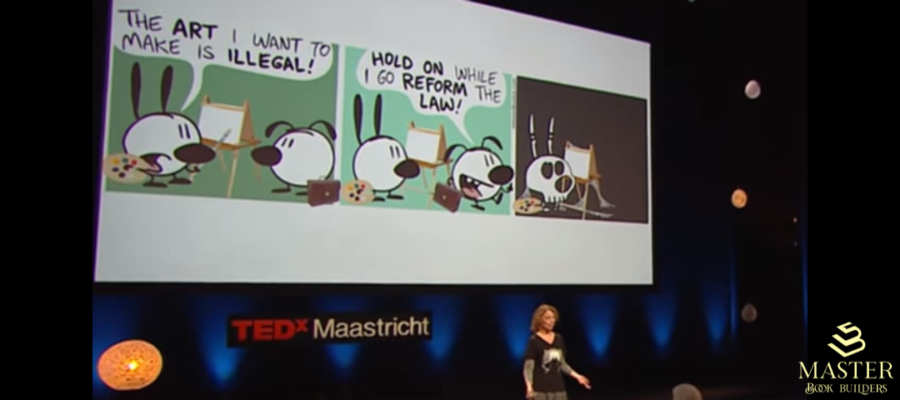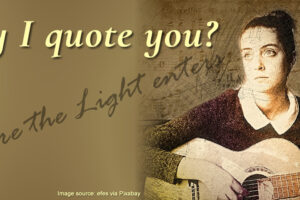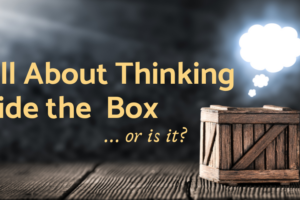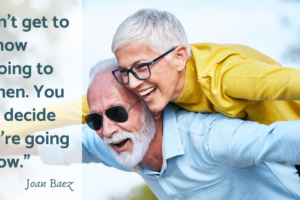Should We Just Abolish Copyright? [Fair Use Revisited, Part 1]
While preparing for my Fair Use workshop at BlogPaws this month (with attorney Shahrina Ankhi-Krol), I found this video with the confrontational title Copyright is Brain Damage. The still image above is used with permission of Nina Paley, the cartoon artist, film maker, and TEDx speaker shown.
Or is it …?
In the description of her talk on YouTube, she notes that her animated film, Sita Sings the Blues, “… like all culture belongs to you [the audience] already.” And in her talk, she calls herself a “copyright abolitionist,” arguing that even the copy-left system of licensing “some rights” through Creative Commons leaves us self-censoring our work. She says the solution to this “permission culture” is “for more and more people to ignore copyright. And I want to be one of those people!”
That sounds like she’s putting her work in the public domain, right?
Don’t kill ALL the lawyers!
Okay, enough suspense. I’m a lawyer (of the “recovering” sort), so I did do some checking and found that Paley has licensed her cartoons under with a “CC-BY-SA Nina Paley” so I’m good. Besides, I’m very confident this use is well within my Fair Use rights. More on that in Part 2.
But let’s stop for a moment and examine why Paley wants to abolish copyright. I mean, she and all artists and authors get the benefit of protection of her work, right? More like, “Yeah, right!”
Unless you’re a lawyer for one of the mega-corporations that control rights in works sold commercially, you are not likely to come up with any serious argument that copyright provides more than pittance to the vast majority of individual authors. For most, the main effect is to prevent their work from being shared and discovered by a wider audience.
Or as Paley puts it, “I realized that actually I wasn’t really making money from copyright. What copyright was doing was blocking the circulation of my comics.” As we’ll see in a moment, her solution of freeing her content with CC licenses, the public domain, and other variants, has been adopted by a growing number of creatives with (perhaps surprisingly) positive results.
On the enforcement side, most individual creators like bloggers, for example, don’t have the time or means to find or enforce the rights against true infringements – by this I mean stealing entire works without crediting and linking to the original – when they do occur. And even if you did have the time and resources to enforce your rights, Paley gets at the fundamental question for creatives whether that’s how we really want to invest them, saying,
“By ignoring copyright we can heal our collective brain damage. I hope you’ll join me in making art, not law.”
Now, Paley admits that even for her, let alone the rest of us, who’ve “been crippled by decades of permission culture indoctrination” ignoring copyright “takes discipline and courage.” You know, worrying about those other lawyers, fines, liability, and such.
So why even consider ignoring copyright?

Copyright self-censorship makes your work SUCK!
Of course, Paley can do what she wants with her own rights, but what about the rights of others? Make no mistake, she is advocating that we ignore each others’ copyrights, too, at least as they have evolved in the law to this point.
Why would we do that? Turns out her argument is pretty compelling and enhanced by her wonderful cartoons, so I urge you take 15 minutes to watch the video. But a summary version runs like this:
- Art is built on ideas and information that first must flow into our minds and be connected.
- Copyright at its core asserts that some of the ideas and information going into you mind cannot come back out without permission and/or payment of royalties.
- This censorship is compounded by the fact that the “owners” of these “rights” don’t have to grant permission or accept the amount of royalty you are able or willing to offer (assuming you can even find the right person to ask or get a response out of them).
- If we allow the ideas, information, and connections that live in our mind to be censored when we are creating, our resulting art will “suck … obviously and hopelessly degraded by copyright censorship.”
Paley likens the flow of ideas from one human mind to another to a neural network, a Great Mind, and ultimately, culture.
The “brain damage” caused by copyright affects both our collective great mind – our culture – and our individual minds, when we self-censor our creative output.
The first item in my summary of her argument uncovers a foundational problem with copyright law.
Copyright is based on a lie
A “damned lie”! Or, as lawyers and judges prefer to call them when they wish to accept lies and build rules upon them, a “legal fiction.”
The lie is written right into the copyright statute, when Section 102 asserts: “Copyright protection subsists … in original works of authorship …” (emphasis added). This is nonsense. As law professor Jessica Litman eloquently explains:
“Our copyright law is based on the charming notion that authors create something from nothing, that works owe their origin to the authors who produce them … that copyright should adjust the balance between the creative individuals who bring new works into being and the greedy public who would steal the fruits of their genius.
“… But the very act of authorship in any medium is more akin to translation and recombination than it is to creating Aphrodite from the foam of the sea.”
She offers specific examples from many forms of art and media:
“Composers recombine sounds they have heard before; playwrights base their characters on bits and pieces drawn from real human beings and other playwrights’ characters; novelists draw their plots from lives and other plots within their experience; software writers use the logic they find in other software; lawyers transform old arguments to fit new facts; cinematographers, actors, choreographers, architects, and sculptors all engage in the process of adapting, transforming, and recombining what is already ‘out there’ in some other form.” (emphasis added)
Echoing Nina Paley’s argument, Professor Litman concludes:
“This is not parasitism: it is the essence of authorship.”
For me, it’s a simple, biological reality that every idea you, or I, or Isaac Newton ever conceived and attempted to communicate was built on uncountable bits of other peoples’ work. By the time we emerge from the womb, we’ve already been absorbing information into our brains. We never stop taking in more and connecting the bits together.
When we express these connections in words, images, sounds, or actions, the result may be beautiful and pleasing to others. But there’s nothing original about it.
Before we decide to abolish copyright, however, let’s consider what would a world without copyright look like for creatives who’d like to earn a living doing their art.

Could artists and authors survive if we abolish copyright?
In a word, yes.
Humans have been producing art for tens, perhaps even hundreds, of thousands of years. Many were making a living at it long before the Statute of Anne, the British precursor to our copyright laws, was enacted until 1710.
Starting in the 1300s and spurred by the printing press around 1440, the creative explosion of science and art in all forms that we call the Renaissance burned brightly for more than 300 years – without any help from copyright laws. Probably not coincidentally, during this same period public libraries arose, making books available for free. A library deed from 1464 expressed it’s purpose this way: “that all who wish to enter for the sake of instruction shall have ‘free access and recess’ at certain times.”
What about today? We seem to be at the beginning of another explosive period of creativity, spurred by the internet this time. Despite the presence of the arsenal of “long and strong” copyright laws we now live under, there are many examples of authors and artists experimenting with making some or all of their works available for free or “nearly free” while simultaneously selling the same or “premium” versions of the same works.
As Cory Doctorow explained in a Guardian article a few years ago,
“My problem isn’t piracy, it’s obscurity, and free ebooks generate more sales than they displace.“
To put numbers on the “more sales” argument, in her 2011 TEDx talk, Copyright in the Digital Age, then law student Lettie Ransley cites the example of Neil Gaiman putting his books on his website for free and a month later his sales had increased 300%! In 2013, comedian Louis CK experimented with offering a self-produced recording of his live show at a “nearly free” price of $5.00, netting $750,000.
It’s not just the perhaps counter-intuitive evidence that offering free digital copies of your work can drive sales of print copies or tickets to the live performance. The benefits to authors and artists can go way beyond any short-term focus on sales of an alternate version of the same work. As Simone Collins (no relation that I know of) wrote in Why Successful Authors Are Giving Their Books Away for Free (emphasis added):
“In addition to enjoying more readers (and thus more word-of-mouth marketing), authors who give their books away for free or at low costs frequently enjoy deeper customer relationships, more reviews, more sales of print books and increased sales of related books, products and services.“
Several well-known authors have succeeded in combining free digital versions with paid print editions: Lawrence Lessig’s Free Culture (Penguin 2005; Creative Commons “BY-NC 1.0” license; free PDF here); Dan Gilmor’s We the Media (O’Reilly Media 2006; Creative Commons “BY-NC-SA 2.0” license; free PDF here); Guy Kawasaki’s Reality Check (Portfolio 2008; a collection of his blog posts, edited and expanded into the book).

In 2006, Robert Scoble and Shel Israel wrote most of their book, Naked Conversations, in public on a blog, inviting reader feedback that they used to improve the manuscript along the way (the blog is no longer online). The book was then published by Wiley, selling well enough to go through hard cover and paperback editions and is now available for Kindle. By 2012, Nina Amir could write a book on her blog about that very thing – writing books on blogs – with the descriptive title, How to Blog a Book: Write, Publish, and Promote Your Work One Post at a Time and get a publishing contract from Writers’ Digest Books. She got a second deal to publish a revised and expanded edition in 2015.
Just last year, our friend Pamela Wilson experimented with a variation of this model by inviting her blog readers into a closed group on her blog to give her feedback on every aspect of her book, Master Content Marketing.
Even in the notoriously copyright-crazed and litigious music industry, superstar artists like Lady Gaga, Ed Sheeran, and Taylor Swift have learned that giving away free access to their music, for example, on their YouTube channels, seems to make good business sense.
Other musicians offer free downloads of music you can use in your own work, such as podcasting or educational videos. Kevin MacLeod’s Incompetech.com/music site offers hundreds of original pieces of digital music you can search by terms like genre, feel, or tempo, or browse in his collections page, under a Creative Commons “BY 3.0” license. Oh, and he also offers paid licenses for uses where you can’t give him credit and will compose original songs or scores just for you for a fee.
More recently, Logan Nickleson’s Music for Makers site offers a free subscription that sends you a new royalty free song every week – written, performed, and recorded by him – that you can use “however you want – commercial projects included.” You don’t even need to credit him “(unless you just want to).” He also offers longer versions of these pieces for per song prices and a pro level subscription that gets you the full collection.
From the users’ point of view, YouTube also seems to be driving an approach to copyright akin to Nina Paley’s “ignore copyright” argument, at least for amateur musicians who are uploading unlicensed covers of copyrighted songs by the millions. As Andy Baio wrote in a 2012 Wired UK article, nearly all of these videos were illegal under current copyright law,
“… created out of love by fans of the source material, with no negative impact on the market value of the original.”
YouTube’s Content ID system now provides a method for identifying these infringements and giving the rights holders an option to allow and monetize them, which apparently many are doing. The program has generated over a billion dollars in royalty revenue to rights holders. According to a recent law review article,
“… users can post any music they want without first obtaining a license, so long as the content owner opts in to Content ID monetization (and most have). In practical effect, Content ID has created a de facto compulsory sync licensing regime.”
There’s a problem with YouTube’s privately negotiated approach, of course. As the Wired article mused,
“But there’s something strange about this begging-for-forgiveness approach to copyright. It’s like driving without traffic signs, only finding out you broke the law when you’re pulled over.
“The real question: Why is it illegal in the first place?
“Cover songs on YouTube are, almost universally, non-commercial in nature. They’re created by fans, mostly amateur musicians, with no negative impact on the market value of the original work. (If anything, it increases demand by acting as a free promotional vehicle for the track.)”
After noting some examples of current stars, notably Justin Bieber, being discovered by posting cover videos on YouTube, the article comes full circle for us, advocating reform of copyright law to completely exempt noncommercial cover songs:
“Now, the next generation of budding pop stars are covering Justin Bieber … It’s all part of the virtuous cycle of culture: We take from it, build on it, and then give back in return. The law should help that along, not hinder it.“
Okay, so we’ve reviewed reasons why copyright often operates to stifle creativity and evidence that authors and artists may get along just fine without copyright laws as they’ve evolved.

Ready to abolish or ignore copyright now?
In another word, no.
Surprised by my answer?
Well, first of all, any attempt to abolish or even substantially reform the copyright regime would take longer than I’m willing to wait, as Paley’s cartoon depicts. As to completely ignoring copyright, I’m not ready to put my reputation and livelihood on the line, in large part because I don’t think the law thwarts creativity as much as Paley argues.
I believe we have several safety valves available to allow the use of other peoples’ work – the public domain, Creative Commons licenses, and most of all our right of Fair Use rooted in the First Amendment – if only we take the time to learn how to use them.
The title of this post hinted that a fuller explanation will come in Fair Use Revisited Part 2. As I mentioned, I found much of the material above while preparing for my Fair Use workshop at BlogPaws 2017. I plan to incorporate more of what I’ll present and what I expect I’ll learn during the workshop into Part 2.
Meanwhile, if you just can’t wait for more on Fair Use, check out this post I wrote prior to last year’s BlogPaws conference: Are You Playing Fair with Copyrights?






1 Comment
Leave your reply.